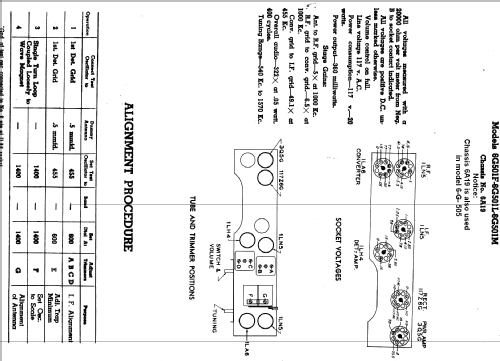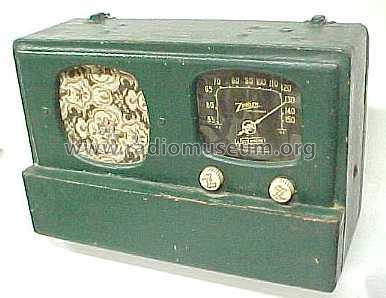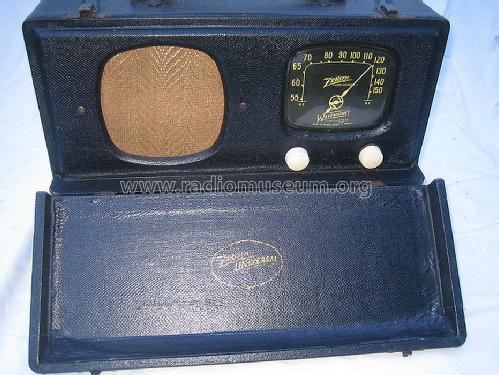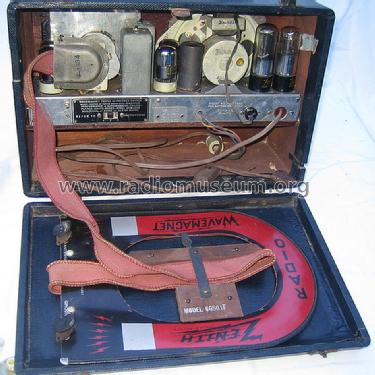6G501F Ch=6A19
Zenith Radio Corp.; Chicago, IL
- País
- Estados Unidos
- Fabricante / Marca
- Zenith Radio Corp.; Chicago, IL
- Año
- 1941
- Categoría
- Radio - o Sintonizador pasado WW2
- Radiomuseum.org ID
- 67770
-
- alternative name: Chicago Radio Lab
Haga clic en la miniatura esquemática para solicitarlo como documento gratuito.
- Numero de valvulas
- 6
- Principio principal
- Superheterodino con paso previo de RF; ZF/IF 455 kHz
- Gama de ondas
- OM (onda media) solamente
- Tensión de funcionamiento
- Red / Baterías o pilas / 117; 90 & 9 Volt
- Altavoz
- Altavoz dinámico (de imán permanente) / Ø 5.5 inch = 14 cm
- Material
- Cuero/Tela/ Plástico sobre otros materiales
- de Radiomuseum.org
- Modelo: 6G501F Ch=6A19 - Zenith Radio Corp.; Chicago,
- Forma
- Portátil > 20 cm (sin la necesidad de una red)
- Ancho, altura, profundidad
- 381 x 249 x 178 mm / 15 x 9.8 x 7 inch
- Peso neto
- 6 kg / 13 lb 3.5 oz (13.216 lb)
- Precio durante el primer año
- 29.95 USD
- Ext. procedencia de los datos
- Ernst Erb
- Procedencia de los datos
- The Radio Collector's Directory and Price Guide 1921 - 1965
- Referencia esquema
- Rider's Perpetual, Volume 12 = ca. 1941 and before
- Mencionado en
- Guide to Old Radios
- Otros modelos
-
Donde encontrará 4517 modelos, 4109 con imágenes y 3654 con esquemas.
Ir al listado general de Zenith Radio Corp.; Chicago, IL
Contribuciones en el Foro acerca de este modelo: Zenith Radio Corp.;: 6G501F Ch=6A19
Hilos: 1 | Mensajes: 7
Please be easy on me, this is my first radio post!
I have rebuilt a Zenith 6g501f. It functions perfectly on battery (actually quite outstanding), but on AC, it appears to have poor sensitivity to the point that the ACG runs the gain up and generates a lot of noise. There's no real hum and the power supply voltages look good - although the filament string voltage is noticeably lower on AC. The alignment also looks very good and the dial tracks remarkably well, far better than any of my transoceanics.
My first thought was that my wall voltage was low, but no, it's right between 116.5-117. The B+ looks good at 85-86V, the filament supply is around 7.9V. Checking the individual tube filaments, they are all around 1.35V (and ~2.8 on the 3q5g) which is very close to specification. I have fiddled with the power resistors and when I raise the filament to ~9 (essentially the same as on battery) it seems to get slightly better, but the required power resistors are down around 850 ohms (vice 1006 ohms per the schematic). I know from Transoceanics that the filament voltage can dramatically effect the performance but I am surprised that the standard voltages seem to result in such poor performance. I have tried several different sets of tubes, some NOS, with essentially no difference in the results. Does anyone in this august body have any better ideas?
Brett
Brett Buck, 06.Jan.11




